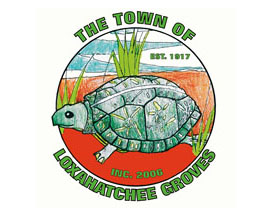On Tuesday, Jan. 21, the Loxahatchee Groves Town Council reviewed a situation on Timberlane Place, a partially private cul-de-sac where large vehicles have difficulty turning around.
Council members were concerned about the effect their decision on that road might have on other roads, many of which are partially privately owned.
According to a report from Town Engineer Larry Peters, the council received an e-mail on Jan. 11 from a resident on Timberlane Place outlining the issue there, explaining that a solution has been proposed, based on the town’s most recent maintenance maps being recorded, which they have not.
The proposed solutions were based on the town owning the eastern portion of Timberlane Place, but no action has been taken to allow the maps to become the town’s official record of rights-of-way, based on maintenance.
The town’s engineering consultant, Keshavarz & Associates, was asked to prepare a conceptual plan with alternatives to a type of turn-around at the west end of Timberlane place and to provide a pull-off at the midpoint of the roadway for vehicles to pass.
Staff presented the conceptual improvement plan to Tim Hart-Woods, the owner of the property at the west end of the road, to review the proposed solution, asking that if the conceptual plan were approved, would he be receptive to bearing the cost of the proposed improvements to his property, which would be a T-turnaround. Hart-Woods indicated he would be willing to relocate his gate to allow the turn-around and bear the costs for most of the improvements, according to the town’s staff report.
Town staff proposed that improvements to the east end of Timberlane at the intersection of West C Road would include widening and a culvert replacement or extension, along with an 80-foot bypass, with the cost bourn by the town once approved by the council.
In an e-mail, Hart-Woods asserted that some of the property owners along the road are putting logs and other debris on the road purposely to narrow it and restrict access, which he noted is the only access some property owners have to their land.
Town Attorney Brian Shutt raised concerns that doing title searches for private property owners might set a precedent for other landowners to do title searches for their property.
Shutt also raised the importance of recording the maintenance maps so that the town could have evidence that it has maintained the road, which gives them evidence that it owns maintenance rights to the road.
“The purpose of the maintenance maps is that it’s better defense in case you get sued,” he said. “If we have maintained that area for seven years… and we can show that we have maintained it, then we can assert ownership of that. Having the maintenance map just makes it a lot cleaner. It’s a quicker defense.”
Town Manager Jamie Titcomb pointed out that some of the town’s records contradict themselves, showing different easements along Timberlane, which he said could be resolved by adopting the most recent maintenance maps, adding that adoption would imply a rather ambitious and expensive maintenance program.
Councilwoman Lisa El-Ramey felt it was dubious to spend the amount of time they had discussing one road when the discussion had more global concerns over the impact it would have on all the roads.
During public comment, Hart-Woods said the road has become narrower over the 10 years he has lived there.
“The access to it is seriously constricted,” he said. “The turn that you’re talking [at West C Road] is quite difficult for large vehicles to make. Quite likely, a large fire-rescue truck wouldn’t be able to make it without reversing back toward the canal.”
Hart-Woods added that an emergency vehicle going down Timberlane, if confronted by an oncoming horse trailer, would not have space to get by and most likely would have to reverse in order to allow the horse trailer to pass. He pointed out that there are only three properties on Timberlane that actually use the road, and he owns two of them. Meanwhile, the people blocking the road have addresses on West C Road.
Shutt suggested that he meet with Titcomb and the town engineer to examine ownership of the area and its history.
“If need be, we can come back at the next meeting,” he said. “If we need to take further steps as far as doing other work, we can let you know. It might be clear on the maintenance maps that were recorded [in 2016]. Evidently, the town did some research back then to determine if this area had been maintained. So, if this is what we’re looking at, then has that changed between now and then?”
If the roadway has been constricted, taking away part of the maintenance area, it could be a question of code enforcement, Shutt said.
Titcomb asked for consensus among the four council members present to come back at the Feb. 4 meeting with opinions on whether the town should do title searches or take other action. Councilwoman Phillis Maniglia was not at the meeting.
“You can make a determination whether or not you want to pursue a title search and if there are any questions about where the footprint is, and then also prioritize that against other road needs and other priorities, because the project itself would end up coming back to you for authorization of the funding,” he said.








